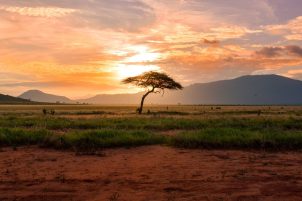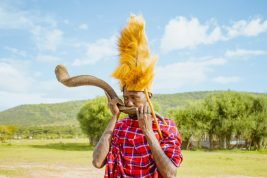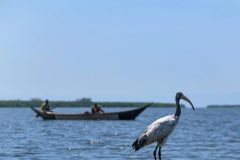Why Visit Kenya?
Kenya offers an exceptional blend of attractions, starting with its 19 national parks and game reserves, the Great Rift Valley, beautiful golf courses, and the picturesque scenes of tea and coffee plantations.
Along the Indian Ocean, pristine white-sand beaches in areas such as Mombasa, Diani, and Lamu provide a perfect setting for water sports and encounters with marine wildlife.
The tourism sector also encompasses eco-tourism, hosting major conferences, cultural exchanges with groups like the Maasai, and sports tourism. This vital industry is Kenya's second-largest source of foreign exchange, underscoring its significant contribution to the national economy, which trails only agriculture.
Location of Kenya
Kenya is defined by its strategic location and diverse geography. It shares land borders with Uganda and Tanzania to the west and south, respectively, and with South Sudan, Somalia, and Ethiopia to the north.
Its eastern boundary is the Indian Ocean, which blesses the country with some of the world's most stunning white-sand beaches, as the Equator runs right through the country. With a vast land area of 580,370 square kilometers, Kenya has ample space for extensive conservation parks and significant agricultural land to sustain its population. The country's official languages are English and Swahili.
The terrain dramatically transitions from low coastal plains bordering the Indian Ocean to a central network of highlands. This elevated landscape is famously bisected by the spectacular Great Rift Valley, which cuts through the mountains.
East of the Rift Valley lies the fertile plateau known as the Kenyan Highlands, recognized as one of Africa’s most productive agricultural regions. Dominating these highlands is Mount Kenya, the continent's second-highest peak after Mount Kilimanjaro, which reaches an impressive height of 5,199 meters (17,057 feet).
Facts About Kenya

Kenya Climate
Kenya boasts a remarkably varied climate, transitioning from the tropical conditions of the coast, marked by high rainfall and temperatures, to the cooler, temperate highlands, and the arid environments of the north, where temperatures fluctuate drastically between day and night. Cooler conditions are found in the central highlands, with nighttime temperatures often dropping significantly, and year-round cold weather dominates high-altitude areas like Mount Kenya. The country experiences two primary rainy seasons, the "long rains" (March/April to May/June) and the "short rains" (October to November), though climate change has intensified these patterns, leading to longer dry spells and more severe, frequent droughts. Despite its location on the equator, Kenya largely follows Southern Hemisphere seasons, with the warmest months occurring from December to March and the coolest from June to August.
The nation's rich cultural fabric is woven from diverse communities, including the coastal Swahili, various Bantu and Nilotic groups, and the culturally prominent Maasai. This diversity is reflected in the country's vibrant arts scene and impressive linguistic landscape, which includes Bantu, Nilo-Saharan, and Cushitic language families, alongside sizable European, Arab, and Asian communities who settled there centuries ago.
While many Kenyans have adopted Western or Islamic dress, traditional attire, jewelry, and adornments remain important for special occasions, especially in remote northern regions, which preserve their traditional lifestyles more strongly.

Culture and People
Kenya is a nation celebrated for its vibrant culture, woven from the distinct customs and traditions of its diverse communities. Major groups include the coastal Swahili, various Bantu populations inhabiting the central and western areas, and Nilotic communities in the northwest.
Even with their smaller numbers, the Masai people hold immense cultural and touristic significance, internationally recognized for their elaborate jewelry and distinctive upper-body adornments. This rich heritage extends beyond traditional life into modern expression, with Kenya boasting a thriving scene in theater, television, and music.
The country's diversity is further amplified by its significant populations of settlers, including Europeans, Arabs, Indians, and Pakistanis, many of whom arrived during the 19th century, adding layers to the national identity.
The remarkable cultural diversity is mirrored in Kenya's impressive linguistic landscape, categorized primarily into three families: Bantu languages (part of the Niger-Congo phylum), Nilo-Saharan languages spoken by about a third of the population, and the Afro-Asiatic Cushitic tongue prevalent in the north.
While many communities have adopted more contemporary Westernized or Islamic forms of dress, traditional tribal attire, jewelry, body adornments, and weaponry remain cherished and utilized for special occasions and celebrations.

Is Kenya Safe?
Kenya is broadly considered a safe and welcoming destination for international travelers.
For your peace of mind, all our meticulously planned Kenyan travel itineraries focus exclusively on regions deemed safe for visitors.
Traveling in a group or with an experienced local guide is always recommended during your African adventures, offering an extra layer of security compared to independent exploration.
Beyond our commitment, the Kenyan government makes tourist safety a top priority. Recognizing that security is a pivotal factor in choosing a holiday destination, the government is fully committed to safeguarding the well-being of all visitors.
Various ongoing initiatives have been implemented across different areas to bolster security measures nationwide.
Finally, prepare to be charmed by the Kenyan people, renowned for their warmth, hospitality, and friendliness. We're confident you'll find engaging with the local communities to be one of the highlights of your trip!
Best Kenya-Uganda Tour Packages
Check out these popular combined safaris in Kenya & Uganda! They're just a few examples of what you can do. You can use these plans to get ideas or start planning. When you're ready, reach out to us, and our team of experts will help you create the perfect safari experience for you
Most Popular Safari Destinations in Kenya.
Tailor-Made Safari
Plan your own safari! You get to decide what you want to do, whether it's gorilla trekking, wildlife drives, boat safaris, cultural visits, or nature hikes. You can even extend your trip to Rwanda, Tanzania, or Uganda. We'll help you choose the best accommodations for a memorable experience.

